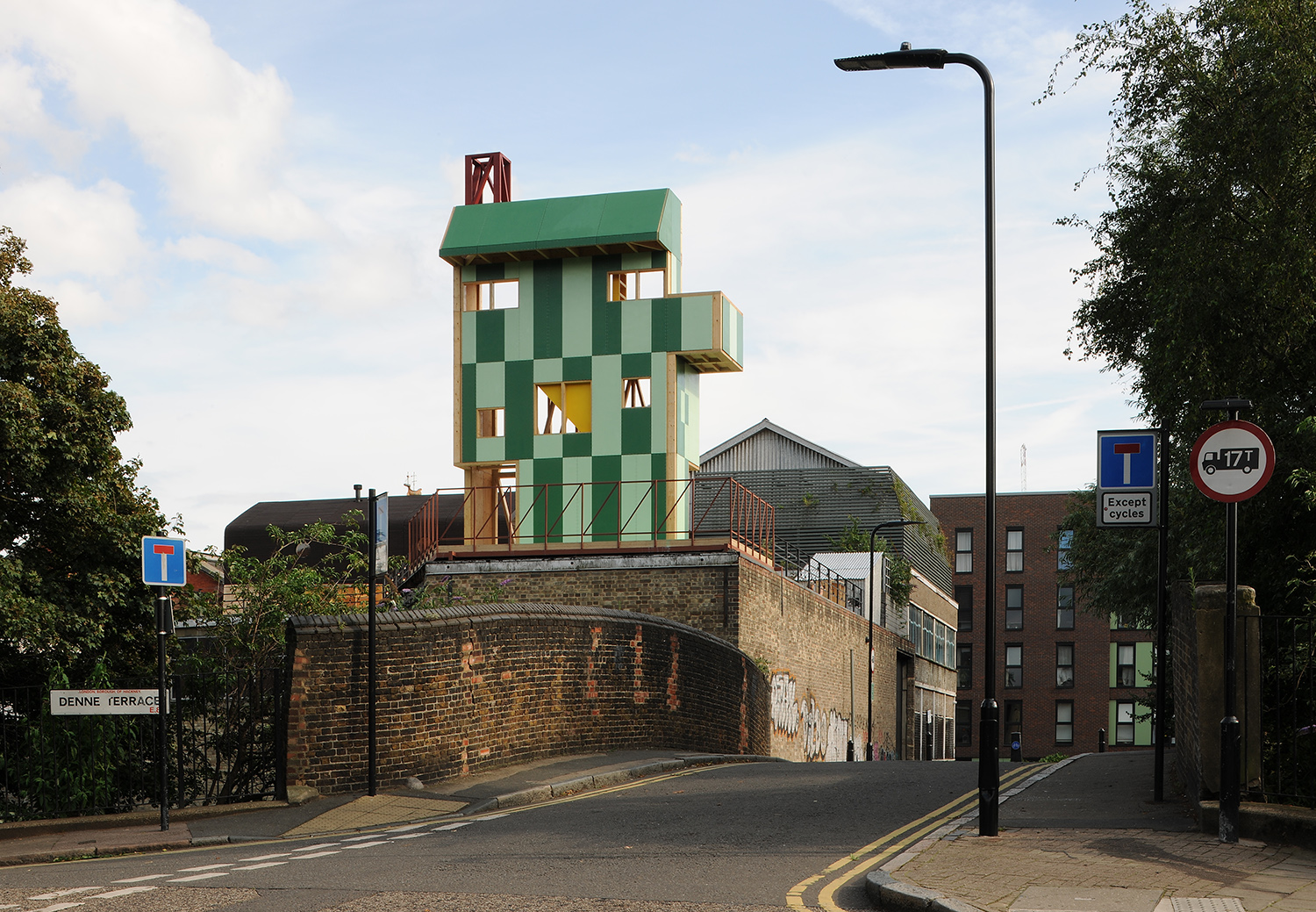Four singing fiberglass sharks are moored in London’s Regents Canal, awaiting a fifth to join the shiver while their benefactors wrestle with local government. Designed by architect Jaimie Shorten, they are part of SHARKS!, this year’s winning entry to the annual Antepavilion design competition run by the Architecture Foundation and the Antepavilion Commission since its launch in 2017.
The pavilion’s site, an events space called Hoxton Docks and its adjacent waterfront, sits within the London Borough of Hackney and is owned by Russell Gray through his company, Shiva. Antepavilion’s temporary nature follows the pattern of pop-up performances and art installations that take place across London every year. And, in employing the local community, including prop-maker Mark Boyes, art workshop Pro-Duck, and artist Josephine Bacon, who worked on this year’s piece, the project supports the blooming arts scene in the borough. The Docks have hosted three winning entries to date. SHARKS! was to be the fourth, until Hackney Council pulled the raft out from under Gray’s feet by filing an injunction hours before the artwork’s reveal on August 21.
The Antepavilion Commission is no stranger to planning warfare; the current competition was launched amid an ongoing effort to save previous pavilions. In 2019, Hackney Council filed an Enforcement Notice requesting the removal of four rooftop structures, including two previous Antepavilions (Potemkin Theatre and H-VAC) on the grounds that the pavilions were constructed without appropriate planning permission. Gray’s team lodged an appeal in December. The 2020 competition brief called for entries that addressed this contentious situation. And so, while the fight for four pavilions was being waged on the roof above, the summer’s sharks were being prepared in the canal below.

Gray said that his team was frustrated by the broad scope of the August injunction, which has apparently aimed to stop activity across the entire premises of Hoxton Docks, in addition to removing the sharks. The Council, Gray grumbled, “is bullying people who don’t have the funds to take them to court.”
But Gray is more than ready to take on the mantle of David against this Goliath. Gray is known equally for arts patronage and for his 1995 installation of Stompie, a decommissioned Soviet-built tank which, despite a planning skirmish with Southwark Council, is still standing.
Armed with a fearless leader in the form of Gray and an enthusiastic social media campaign, the Antepavilion team is encouraging individuals to send letters in support of the endangered sculptures via email to the Hackney Council by October 8. A hearing has been scheduled for October 14.
When requested for comment on the injunction, a spokesperson for the Hackney Council said it has, “a legal duty to investigate all reported breaches of planning control. An investigation into the Sharks! [sic] installation found the proposed artwork to pose a significant risk to public safety and would adversely affect the amenities of nearby residents, and, would result in unacceptable harm to the character and appearance of a conservation area. Effective Planning Enforcement is vital in order to maintain public confidence in the planning system and the Council will continue to take action as required against rogue developers for the wider benefit of the community.”
What is at stake here is not simply public safety or the character of the Regent’s Canal Conservation Area. The case raises the same questions embedded in this year’s call for proposals: Where should the public draw the line on the government’s role in shaping the built environment, and to what extent is a temporary work of art obliged to play by government rules?
SHARKS! strikes with joie de vivre. Sadly, the bubble-blowing fish find themselves in an architectural sea that has been clouded by fear for some time. Eager overseas investors trawl inner London, building expansive projects of varying quality. Underfunded councils tread water at the mercy of private developers to meet immense housing targets. And a disenfranchised public remains parched, subsisting on a paltry meal of unaffordable housing and a long list of winners of the Carbuncle Cup, the award for “the ugliest building in the United Kingdom.”
Shorten’s sharks find themselves at the center of this circus of contemporary planning, with Hackney Council crying foul on allegedly illegal and “ugly” interventions, the Antepavilion team rallying to defend and fund its art, and the public bemoaning the loss of much-needed levity after a taxing summer.
Gray believes that, like the landmark case of the 1986 Headington Shark (which defended a 25-foot shark sculpture added to the roof of an otherwise demure, brick house in Oxford, England), the scope of the recent injunction may be grounds for challenging a dated planning system.
“Injunctions were used in rare cases,” Gray said, “and this opens the door for them to be used [by authorities] much more capriciously and self-servingly.”
In what will likely be a drawn-out debate, the many nuances of the English planning system, peppered as it is with vague technicalities, will come into play in determining whether the collection of pavilions was legally constructed. The plight of the sharks, and their rooftop comrades, will rely on the ability of Gray and his team to make a compelling case for the Antepavilion projects in light of the varied objections placed by the Council, the complex context of the site, and the temporary nature of the art-architectural artifacts.
This year’s installation, Shorten said wryly, “is not the sort of thing I normally do.”
Shorten, a partner at Barker Shorten Architects, is better known for straightforward buildings than outlandish structures.
“But there’s been a good response to [the sharks],” he said. “Some people are mystified, some people think they’re funny. I suppose they’re what my children used to accuse me of—being ‘random’—and that’s the intention. It’s absurdism, and it seems to work with the year we’ve been having.”











